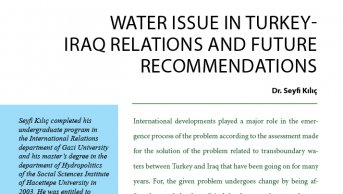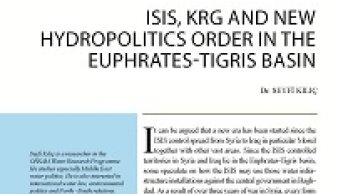Historical Roots of the Blue Nile Conflict between Egypt and Ethiopia and its Present Reflections

The importance of the Nile for Egypt has been referred to many times since ancient times.
The first reference is “Hymn to the Nile,” known to have been written for the river around 2100 B.C. In the hymn, the River Nile is considered as keeping Egypt alive and is praised. Another reference was made by the well-known Greek historian Herodotus. Herodotus called Egypt “the gift of Nile.”
In modern times, the most important emphasis on the importance of the Nile for Egypt is the statement made by Anwar Sadat, then president of Egypt, after signing the peace treaty with Israel on March 26, 1979. Stating that the only issue that could drag Egypt into a war was water, Anwar Sadat both declared that the dominant role of Egypt in Arab-Israeli conflict was over, and also highlighted the vital importance of the Nile for Egypt.
Many countries are located in the Nile basin as it is the longest river in the world. The number of countries in the basin reached 11 after South Sudan gained its independence from the Khartoum administration in July 2011. The basin, which covers more than three million square kilometers, has neither economic nor strategic integrity. Hence, adopting a joint position in terms of using the Nile waters through mutual compromises among the basin countries gets more difficult.
Egypt became an important hub for cotton production starting from the period of Muhammad Ali Pasha, who later launched a revolt against the Ottoman Empire. Gaining more importance in international trade after the opening of the Suez Canal, Egypt began to play a key role in terms of British colonial policy. After the British invasion of Egypt in 1882, Britain attached a particular importance to cotton production in Egypt for its textile industry. Starting from that period, Britain, which was aware of the fact that it was not possible to produce cotton without irrigation, initiated certain international regulations to prevent upper riparians from using the Nile waters before they reach Egypt. Those regulations were made by European colonialist states seizing control of the territories located on the upper side of the basin during that period. Those regulations can be listed as follows:
April 15, 1891 -- Protocol between the United Kingdom and Italy
Article III of the protocol, signed between Britain and Italy on East Africa in 1891, states that Ethiopia will not attempt any water resource development activities on Atbarah -- one of the tributaries of Nile.
May 15, 1902 -- Treaty between Great Britain and Ethiopia
In the Britain-Ethiopia treaty dated May 15, 1902, Ethiopia agreed on not to build any constructions that might obstruct the river's waters on Lake Tana, the source of Blue Nile and Sobat River, without agreeing with the British administration in Sudan. However, in the 1950s, Ethiopia stated that the Treaty was never ratified and was not binding for that reason.
May 9, 1906 -- United Kingdom-Belgium Agreement
In 1906, the Belgian Congo administration undertook not to construct, or allow to be constructed, any work over or near the Semliki or Isango River which would diminish the volume of water entering Lake Albert except in agreement with the Sudanese Government.
Dec. 13, 1906 -- United Kingdom-France-Italy Agreement
Through this agreement Britain, France and Italy agreed to safeguard the interests of Great Britain and Egypt in the Nile Basin, more particularly as regards the regulation of the waters of the Blue Nile River and its tributaries.
The 1925 Exchange of Notes between Britain and Italy
In the 1925, with the Britain-Italy exchange of notes, the Italian government guaranteed not to perform any hydraulic work on the Blue Nile and accepted the “vested rights” of Egypt and Britain.
May 7, 1929 -- Exchange of Notes between the United Kingdom and Egypt on Use of Waters of the Nile for Irrigation
The 1929 Agreement was signed between Egypt and Britain representing Sudan, Kenya, Tanzania and Uganda. The agreement prioritized Egypt's utilizations of the Nile water. In accordance with the agreement, Egypt and Sudan utilized 48 and 4 billion cubic meters of the Nile flow per year, respectively; the flow of the Nile from January to July (dry season) was reserved for Egypt; and Egypt reserved the right to monitor the Nile flow in countries upstream and to veto any construction projects that would affect her interests adversely. However, this agreement was never applied in Kenya and Tanzania, and those countries asserted that the agreement became obsolete after they gained their independence.
An article in the 1929 Nile Waters Agreement that states there can be no irrigation or energy project in Sudan or any other region under Britain's control, on the Nile or the lakes that are the source of Nile which will decrease or delay the waters flowing to Egypt shows the importance that Britain attributed to Nile and on agricultural production in Egypt.
Nov. 8, 1959 -- Egypt-Sudan Nile Waters Agreement
This was the most comprehensive agreement related to the Nile basin. According to the agreement, the quantity of average annual Nile flow was settled and agreed to be about 84 billion cubic meters measured at the Aswan High Dam in Egypt. While the agreement granted Egypt the right to construct a dam in Aswan, it granted Sudan the right to construct the Rosaries Dam on the Blue Nile. It is also decreed that additional water, gained from the development works on the White Nile, would be shared equally by the two states. Both countries agreed to establish a Permanent Joint Technical Commission, and to adopt a joint approach in case other riparian states demanded the reallocation of waters. What grabs attention regarding the agreement is the fact that Egypt and Sudan did not operate any consultancy mechanism with other basin countries while carrying on negotiations.
In 2010, Rwanda, Ethiopia, Uganda and Tanzania signed the Nile Basin Cooperative Framework Agreement as a result of years of efforts regarding the utilization of the Nile. In the 1990s, the Nile Basin Initiative (NBI) was launched as a partnership to seek a solution for problems in the basin. However, as downstream riparians, Egypt and Sudan continued to ignore the rights of the upstream countries on the utilization of the river's waters and insisted that the international regulations dating back to the colonial period were still binding. The 2010 Agreement, which can be regarded a reaction to this situation, emphasizes the rights of each basin country to equitably utilize the Nile waters. Although Ethiopia signed the agreement, it was not accepted in the parliament until June 13, 2013, after being threatened with military intervention by Egypt.
Although Ethiopia contributes 85 percent of the total Nile flow annually, the country cannot considerably benefit from the river. Going through long-term internal conflicts and a cycle of war, Ethiopia has a quite low income per capita. Ethiopia, which needs electricity for both its developing industry and domestic use, turned towards hydroelectric power generation, which the country considered the cheapest resource. Ethiopian laborers and civil servants contributed a lot to finance the Grand Ethiopian Renaissance Dam, with the capacity to generate some 6000 MW of energy, and the dam became a national issue for Ethiopia. Egypt's objection to the diversion of the river waters, which is a basic technique for the construction of a dam and to the dam itself is inexplicable in political terms. The Renaissance Dam is being constructed only with the aim of generating energy. This means that the dam will not consume water; namely, there will not be any change in terms of the amount of water flowing down the Nile.
Looking from Egypt's point of view, the current problem highlights that Egypt will no more benefit unilaterally from the waters of the river Nile as it did for centuries. Egypt's objection to construction of the dam can be explained by the policy of preventing any upstream riparian utilization from the Nile waters. This policy has no applicability these days and it is doomed to fail. Any policy to prevent upstream riparians from utilizing the river water does not yield results anymore. The Egyptian government might try to take advantage of the situation to overcome the hard times it has been going through in domestic politics. However, Sudan, which has been its loyal ally in terms of the Nile River so far, has also begun to regard the dam being constructed in Ethiopia as “beneficial.” It should be taken into consideration that Egypt needs Sudan for a military intervention in Ethiopia over the dam. The Egyptian air forces have no tanker aircraft, which would be needed for such a military operation. The Egyptian aircraft would be able to reach Ethiopia only if Sudan provided them with an airbase. Nevertheless, it is understood from the latest statements from Sudan that it does not favor this option. In the event that Ethiopia rejects military cooperation, another option would be a military operation to be carried out with Special Forces, but this is also doubtful. The Renaissance Dam is so grand that it cannot be damaged through materials carried by a small team. Another option for Egypt is that the construction of the dam can be prevented through support to certain opposition groups in Ethiopia. The military capacity of those groups is not known. It is not hard to predict that Ethiopia will take counter measures after hearing all those options to prevent them from being implemented.
In conclusion, it should be acknowledged that the political turmoil in Egypt limits the realm of activity of the government. The disturbance of the so-called Arab Spring is still being observed in Egypt as the army ousted former President Mohammed Morsi. The idea of undertaking an external military adventure seems highly unlikely in a period like this.










